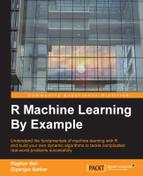In this chapter, we continued our pursuit of using machine learning in the field of e-commerce to enhance sales and overall user experience. The previous chapter had discussed recommendations based on transactional logs; in this chapter, we accounted for the human factor and looked into the recommendation engines based on user behavior.
We started off by understanding what recommendation systems and their classifications into user-based, content-based, and hybrid recommender systems. We touched on the problems associated with recommender engines in general. Then we dived deep into the specifics of collaborative filters and discussed the math around prediction and similarity measures. After getting our basics straight, we moved onto building a recommender engine of our own from scratch. We utilized matrix factorization to build a recommender engine step by step using a small dummy dataset. We then moved onto building a production ready recommender engine using R's popular library called recommenderlab. We used user-based CF as our core algorithm to build a recommendation model on a bigger dataset containing ratings for 100 products by 5,000 users. We closed our discussion by evaluating our recommendation model using recommenderlab's utility methods.
The next couple of chapters will move from e-commerce to the financial domain and utilize machine learning for some more interesting use cases.
